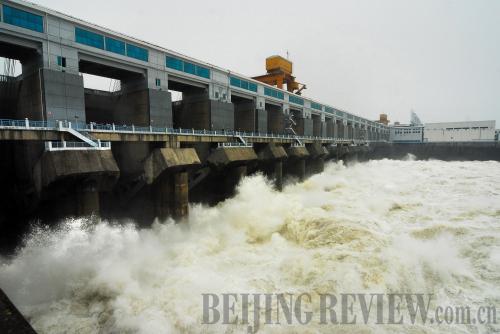|
 |
|
THE POWER OF WATER: Since coming into operation in July 1981, the Gezhouba water conservancy project in central China's Hubei Province has provided 416 billion kwh of clean energy, saving 160 million tons of standard coal and reducing carbon emissions by 400 million tons (XIAO YIJIU) |
Sinohydro Group Ltd., the world's biggest hydropower and water conservancy facilities construction company, took to the road from September 20 to 21, from Shenzhen to Beijing, to promote its upcoming initial public offering (IPO) planned for the Shanghai Stock Exchange this October.
Sinohydro was established in 2009 to meet the demand of reform of China's power industry. In April this year, the State-Owned Assets Supervision and Administration Commission decided on reforming power grid enterprises and reorganizing power designing and constructing enterprises. According to the plan, the auxiliary companies of State Grid Corp. of China and China Southern Power Grid Co. Ltd. in 14 provinces, autonomous regions and municipalities, as well as Sinohydro Corp. Ltd. and HydroChina Corp., will be grouped into China Power Construction Group Co. Sinohydro will become the capital operation platform for China Power Construction Group Co.
Moreover, China will also reorganize the auxiliary enterprises of the State Grid Corp. of China and China Southern Power Grid Co. Ltd. in 15 provinces, autonomous regions and municipalities as well as China Gezhouba (Group) Corp. and China Power Engineering Consulting (Group) Corp. into China Energy Construction Group Co. The listed China Gezhouba will be the capital operation platform for the new company.
In China's power industry market, China Power Construction Group Co. and China Energy Construction Group Co. will be both partners and rivals in power construction and transmission.
Sinohydro's IPO indicates that reforms to China's power mechanism are taking root.
Sinohydro Group Ltd. was jointly established by Sinohydro Corp. Ltd. and HydroChina Corp. Sinohydro Corp. Ltd. holds 99 percent of shares in the form of businesses of engineering, power investment and operation, real estate development, equipment manufacturing and leasing, while HydroChina Corp. holds 1 percent of shares in cash.
By the end of 2009, Sinohydro Group Ltd. had total assets of 95.56 billion yuan ($14.98 billion), operating 18 wholly owned subsidiaries in China, nine holding companies, one joint stock company and 47 overseas offices. It has contracted engineering projects as well as economic and technology cooperation projects in more than 50 countries and regions in Asia, Africa, Europe and the United States, holding 50 percent of the market share in the water conservancy and hydropower industry.
According to an investment report of the construction industry released by Guotai Junan Securities Co. Ltd., in China's hydropower and water conservancy construction market, China Gezhouba (Group) Corp. holds 25 percent of the market share while Sinohydro holds 70 percent.
According to its IPO prospectus, Sinohydro plans to issue up to 3.5 billion new shares to raise 17.31 billion yuan ($2.53 billion). This will represent close to 35 percent of its expanded share capital and could be the biggest IPO on the Chinese mainland this year. The prospectus said the funds raised will be used to buy new equipment and invest in clean energy projects and public infrastructure construction in addition to supplementing cash flows.
Han Xiaoping, chief information officer of China5e.com, a Chinese energy website, said China's demand for electric power is growing, but the country is restrained by a shortage of coal, causing its power industry to look to alternative fuel sources, primarily hydropower.
Over the next five years China will focus on large-scale hydropower projects, and Sinohydro's IPO undoubtedly supports this new direction, said Han.
Until 1985, China had not implemented uniform and planned management mechanism in the power industry. The Central Government was the only decision maker of the whole country's electricity industry, responsible for resource allocation and directly organizing power production and supply, as well as power investment and construction.
Sun Xiaojie, a professor at North China Electric Power University, said the planned economy practiced by China before 1978 had seriously restrained development of the power industry and led to the country's power shortages for more than 20 years.
| 